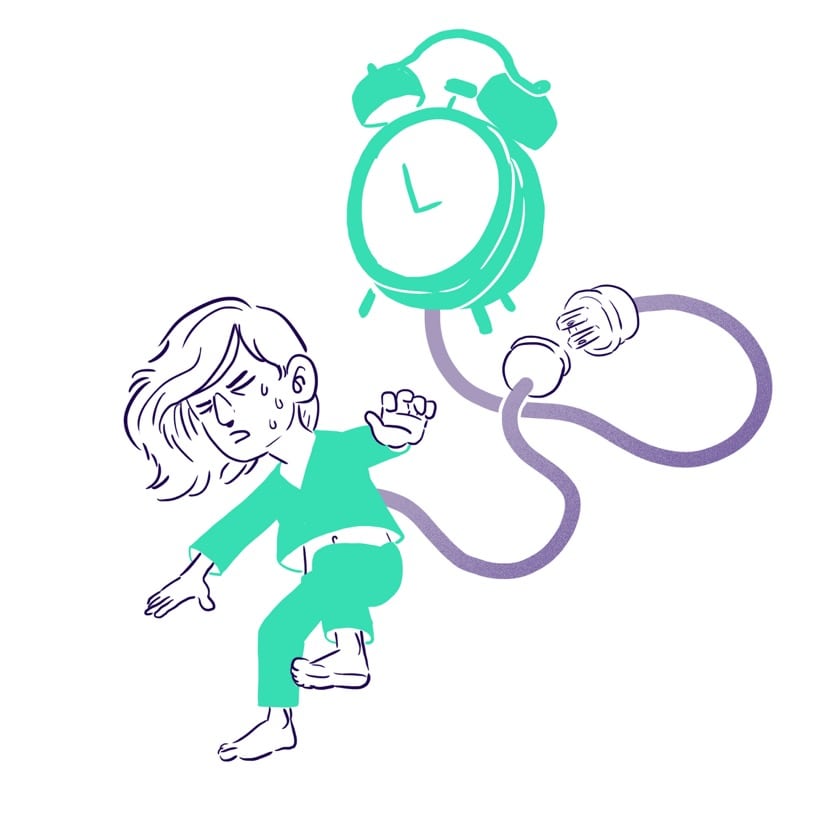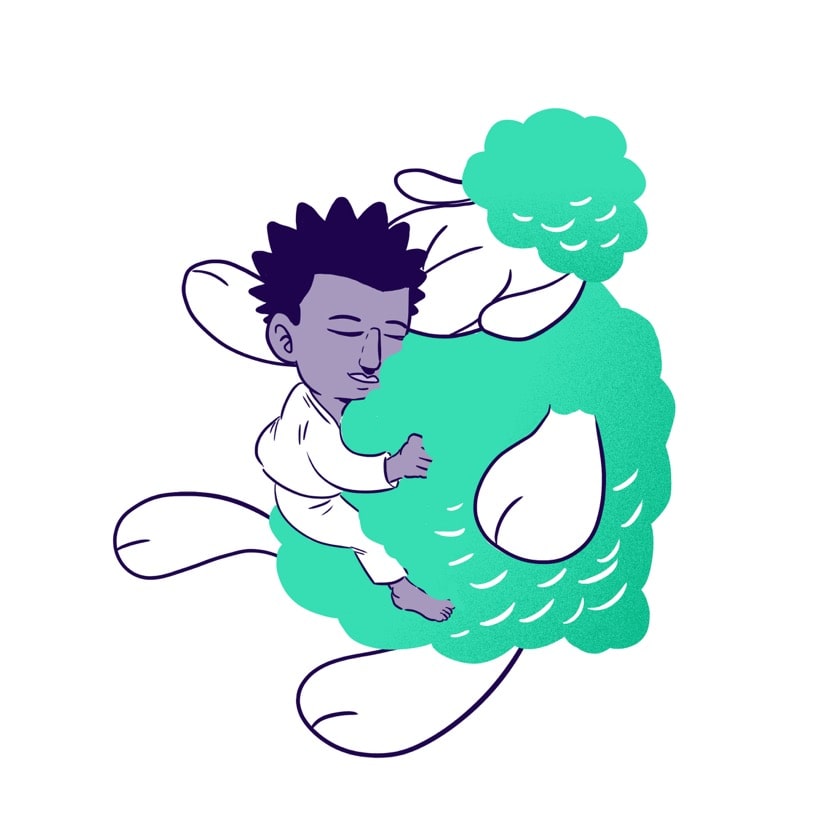Night terror, or the nightmare of parents for their children
A "night terror," that could have made a striking title for a B-movie, in other words a film meant to scare or distress. Despite our strong liking for the 7th art, here we will focus on night terrors as a parasomnia and, once is not customary, this sleep disorder concerns almost exclusively children under 18 years old. Like horror movies, also forbidden for under 18s? That's kind of it, indeed, except that children are not aiming for an Oscar for their performance!
More seriously, night terrors, in their manifestations, can turn out to be a distressing, sometimes frightening scene, and the helplessness of parents facing this scene is all the more frustrating. What do we really know about night terrors? If we know they can be spectacular, are they therefore dangerous? Is there a difference between nightmares and night terrors? These are certainly questions that those around people suffering from this spectacular and particular sleep disorder must ask themselves, and rightly so. Don't panic, let yourself be guided by our chief sleep director to help you better understand night terrors, and thus better manage them if you ever face them!

What is a night terror?
This is a sleep disorder classified among the slow-wave sleep parasomnias (undesirable events, abnormal behaviors occurring during sleep) and most often occurs in children, between 3 and 6 years old. However, a small proportion of adults, around 2.2%1, may face this phenomenon. The origins of night terrors in adults could differ from those in children. A neurological disorder2, for example, could be one of the causes behind this parasomnia in adults, although this theory requires further investigation.
Night terrors occur during the first 3 hours of sleep. They actually correspond to a problem in the transition between the deep sleep phase and the REM sleep phase (dreams, nightmares). It should be known that during this slow-wave deep sleep phase, night terrors can be accompanied by another parasomnia of the same type, sleepwalking. The prevalence of this “association” is not yet clearly established, but a recent study3 has looked into the subject. To be continued!
During a night terror, the child agitates, showing characteristic elements of fear such as screams, sweat, or rapid breathing. While this spectacular phenomenon can be traumatic for parents or anyone witnessing it, children retain no memory of it, and this is where night terrors differ from nightmares. You can remember a beautiful dream or an unpleasant nightmare, but you do not remember having experienced a night terror, which is rather a good thing, you will agree!
Night terror is therefore synonymous with a difficult and restless beginning of the night, but the person suffering from it is not aware and remains asleep, even if their eyes are open. This disruption of the sleep cycle stops on its own and usually lasts from 2 to 20 minutes at most, just the time for a somewhat agitated little scene.
Night terrors in numbers
As mentioned earlier, night terrors mainly affect young children. Although figures may vary somewhat depending on age groups, it can nevertheless be estimated that 5% of children experience night terrors4.
A recent study estimates the prevalence of night terrors "between 1 and 6.5%5" among children aged 1 to 12 years. While figures may vary depending on studies on general prevalence, they mostly agree that the "peak" of night terror activity occurs between ages 4 and 7, and that this phenomenon concerns nearly 40% of children under 6 years old6.
We can therefore observe, based on these figures, that night terrors mainly occur between ages 4 and 7, then significantly decrease from age 12 onwards, once sleep cycles are well established. However, as we mentioned earlier, a very small minority of adults, just over 2%, may face this phenomenon during their lifetime. After all, a little parental solidarity is needed in this area too!
What are the causes of night terrors?
First of all, it is important to clearly differentiate nightmares and night terrors. Here is a brief reminder of the main characteristics of nightmares:
- it occurs during REM sleep, that is, at the end of the night
- it can be remembered upon waking
- it can be caused by traumatic events, stress, or in response to drug withdrawal
Regarding night terrors, their onset early in the night results from a "failed" transition between slow-wave sleep and REM sleep. Although they are close to sleepwalking and nightmares, also considered parasomnias, night terrors have their own causes.
Indeed, numerous studies have highlighted a set of probable causes for night terrors. According to organizations specializing in sleep research, such as " Sleep Foundation7 ", and referring to a recent study8, it can be considered that the main causes of night terrors are the following:
- lack of sleep (especially stopping naps for 4-6 year olds)
- fatigue
- irregular sleep hours and rhythms
- fever
- sleep apnea
- intense physical activity
- medication intake
- noisy environment, too much light
If, for younger children, lack of sleep remains the main cause of night terrors, it is also possible to consider stress (or any traumatic event) when these disturbances persist beyond the age of 6. Indeed, at this age, sleep cycles are considered well established, and the biological clock (“circadian rhythm”) should be set.
Furthermore, some studies report a genetic factor favoring predisposition to night terrors (as well as to sleepwalking). One of them9 reports that 96% of people subject to night terrors have a family member who has already faced one or another of these parasomnias (this figure is 80% for sleepwalking). In other words, a small family survey can be very useful to prepare for the possibility of restless nights and spectacular scenes with your child!
How do night terrors manifest?
You wonder how to recognize a night terror? For this parasomnia, the symptoms are quite easily identifiable and are very characteristic of the phenomenon. As the saying goes, “you know who you are dealing with” when this sleep disorder occurs. Here are the symptoms of a night terror:
- the child (or adult) sits up
- manifestations of crying, screaming (the famous “Hitchcockian” scream!)
- despite the state of unconsciousness, the eyes are open (in “mydriasis”)
- onset of sweating (hypersudation)
- accelerated breathing (tachycardia)
- the skin tone becomes redder (erythrosis)
- pronunciation of incomprehensible or incoherent words
- agitation, defensive or struggling movement
You will have understood, the manifestations of a night terror can distress or even shock the "spectators." The first phase is quite brutal: the child sits up, sits, their eyes open, and then, we witness a real scene of crying and fear, accompanied by screams. This is followed by spectacular agitation, all at the rapid pace of frantic breathing, the child struggles vigorously. Out of breath, this episode stops abruptly, sometimes after a few minutes, without the child remembering anything. The night's sleep then continues, the child falls back asleep, even if they were not awake, because unconscious, and returns to the land of dreams.
If the privilege of remembering the scene belongs to the parent, the child suffers no aftereffects and retains no trace of this night terror in their memory, and that is the main thing!

Diagnosis and treatment of night terrors
This is a differential diagnosis, meaning that other parasomnias or pathologies that could cause the same symptoms are sought to be ruled out.
Thus, characterizing and diagnosing a night terror is quite simple overall. Indeed, only nightmares and hypnagogic hallucinations (related to sleep paralysis) cause a set of similar symptoms. As noted by Dr. Marie-Josèphe Challamel10, pediatrician at the "Centre du Sommeil de Lyon" and research officer at "INSERM", "in both cases, the child is fully conscious and awake," which allows differentiating night terrors from nightmares (which, moreover, occur later in the sleep cycle), but also from hypnagogic hallucinations. Differential diagnosis with other pathologies such as sleepwalking, narcolepsy, or others can be made through a medical consultation, notably thanks to polysomnography or an examination in a sleep center.
Here too, regarding treatment, it is quite easy to identify since... there isn't any! More precisely, doctors agree that night terrors are not abnormal, they correspond to a form of maturation of sleep cycles. Therefore, the treatment actually corresponds more to support during the manifestation of this disorder, by ensuring the environment is safe (furniture or objects), especially to avoid possible injury during agitation and uncontrolled excessive movements. Attempts to reassure the child are, unfortunately, futile and useless, as the child is not in a conscious state.
However, even if it might help parents get through this crisis feeling more useful, it is preferable not to intervene (by words or actions), at the risk of prolonging the episode or amplifying the child's defensive movements. It must be kept in mind that a night terror is, fundamentally, perfectly normal at the childhood stage!
Although there is no standard treatment for night terrors, it is nevertheless possible to limit known aggravating factors. In doing so, it is possible to follow these few recommendations:
- implementation of naps during the day
- scheduled awakening11: after observing and noting the usual delay between falling asleep and the night terror, one can schedule the child's awakening12 10-15 minutes before, to prevent the episode, then let them fall back asleep after 5 minutes
- practice "cosleeping13": a new medical approach consisting of creating a secure environment for the child to reduce stress during periods prone to night terrors
- adopt an appropriate lifestyle and sleep hygiene (regular bedtime schedules, diet, avoid intense physical activity during the day...)
The use of medication is generally prohibited for treating night terrors, as side effects, especially in children, can be dangerous. However, in rare cases and for a very short duration, "benzodiazepines" may be prescribed to relieve acute and very frequent episodes, which can be too distressing in the long term.
For adults who continue to suffer from night terrors, treatments, also of short duration, can be considered:
- paroxetine (antidepressant)
- melatonin
- carbamazepine
Night terrors are as distressing for the "spectator" parents as they are not dangerous for the children, provided that a safe environment is ensured and agitated movements are monitored to prevent minor injuries. The film of life sometimes unfolds with spectacularly restless and noisy surprises, thus adding the necessary spice to the appreciation of its outcome. Night terrors are therefore sometimes part of the scenario, contributing to the establishment of the internal clock and circadian rhythm in our beloved little ones. We must cope with this mischievous sleep disorder... for a few episodes!
To complement and illustrate the content of this article, here is a little bonus video, just for you:
an explanation about parasomnias, by Joëlle Adrien, neurobiologist and research director at INSERM
Sources:
[1] Slow-wave sleep parasomnias, Dr N. Limousin, site « Collège des enseignants de neurologie », 2020 [2] Night Terrors, « StatPearls », July 2020 [3] Sleepwalking and Sleep terrors, site « Harvard Health Publishing », February 2020 [4] Sleepwalking, nightmares, and night terrors in children, site « Fondation Sommeil », 2020 [5], [8] and [12] Sleep terrors: an updated review, Alexander K C Leung 1, Amy A M Leung et al, « Current Pediatric Reviews », October 2019 [6] The different types of sleep disorders in children, site « Ameli.fr », April 2020 [7] Night Terrors: when to talk with a doctor, site « Sleep Fundation », July 2020 [9] Hereditary factors in sleepwalking and night terrors, A. Kales, C. R. Soldatos et al, « The British Journal of Psychiatry », August 1980 [10] Child parasomnias, Dr Marie Josèphe Challamel, site « Université Lyon 1 », 2020 [11] Night Terrors, Ngoc L. Van Horn, Megan Street, « StatPearls », July 2020 [13] An evolutionary perspective on night terrors, Sean D Boyden, Martha Pott et al, « Evolution, Medicine and Public Health », April 2018
